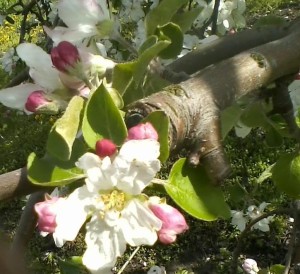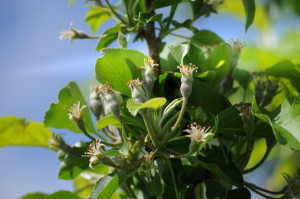May has faded into the warm days of June. Mother Nature has blessed us with sufficient rainfalls and the storms of summer has so far evaded our area. Threatening dark clouds and storm warnings worry those of us in the orchard business. A beautiful crop of fruit can become less beautiful in a short time with a hailstorm. No matter the size of the hail, the apples are now at a growth stage that any hail will cause damage to the fruit. While the actual fruit is not damaged, hail causes “cosmetic” damage as it marks the apples with indentations.
Growing conditions have been very good in our region. The grass continues to grow as do the weeds. We continue to use the mower, weedeater and as little herbicides as we can as we maintain the orchards throughout the summer. Applications of fungicides and insecticides continue to be an important program as the fruit puts on growth and continue to need protection. We are starting to discover small areas of fire blight which is a bacterial infection of the branches of the trees. We try to control this disease by pruning those infected branches and destroying them so the infection can not be spread. Fire blight is a serious disease in an orchard and must be treated aggressively. Passive attention to it can cause an “epidemic.” Trees actually die from a fire blight infestation.
Every orchard has a “June drop” and we have experienced a rather heavy drop this year. “June drop” is a shedding of fruit by the tree itself and is nature’s way of thinning. Some factors affecting this “drop” is a lack of good pollination usually due to a shortage of bees in the orchard. Another cause of a larger “June” drop this year is the extremely large harvest of fruit last season. Trees drop their load to protect themselves. It is just part of nature and needs to be accepted as such. Nature takes care to protect itself.



